The use of formic alcohol as a single drug and as one of the therapeutic ingredients in the manufacture of ointments and solutions is widely practiced in various fields of medicine.
Formic alcohol is a synthetic medicinal product for cutaneous use in the form of a solution of synthetic formic acid in ethyl alcohol, which has an antiseptic, locally irritating, anti-inflammatory effect.
Belongs to a number of OTC drugs, it looks like a clear liquid with a specific odor. The average cost ranges from 10 to 25 rubles.
Material Content:
Active substance
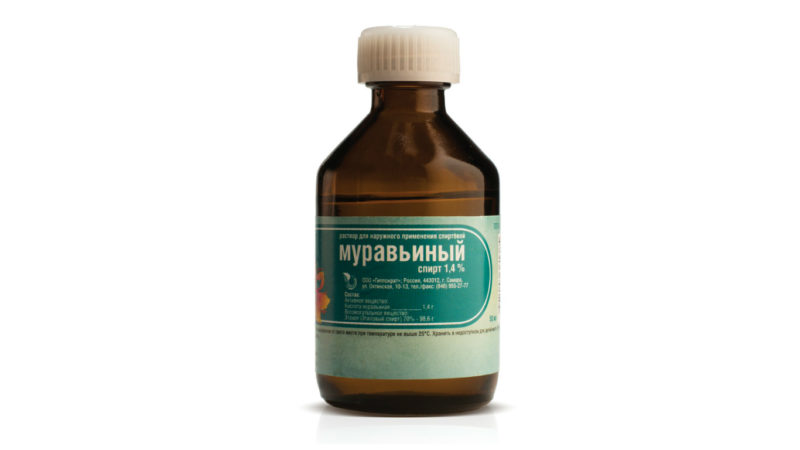
The therapeutic basis of the medication is formic acid, which belongs to saturated carboxylic acids. Sometimes in the medical literature there is another term - methane acid.
Natural sources that contain formic acid include nettles, avocados, needles, strawberries, as well as the secret secreted by the glands of bees and ants. In industrial quantities for medical purposes, the product is obtained by organic synthesis. Its basic property is the slowdown of rotting processes.
In its pure form, the substance poses a health hazard. Acids with a concentration above 10% (maximum permissible) when applied externally can cause a chemical burn on the skin, and inhalation of acid fumes can lead to damage to the respiratory system and vision.
The concentration of acid dissolved in formic alcohol, 1.4%, is accurately calculated and completely safe for medical use.
Composition and form of release
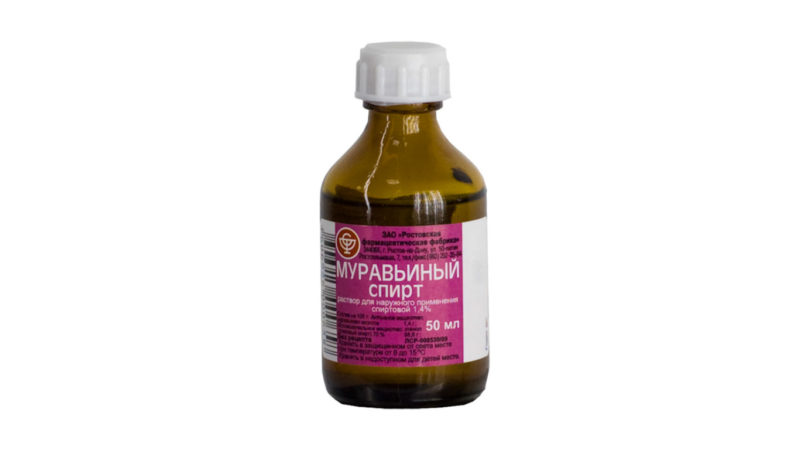
Formic alcohol contains ethyl alcohol at a concentration of 70% and pure formic acid.
In 100 ml of a solution with a concentration of 1.4% contains 98.6 ml of ethyl alcohol and 1.4 ml of synthetic acid.
The dosage form of the drug delivered to pharmacies is an alcohol-containing solution poured into 50 ml vials of dark glass. It is placed in a cardboard bundle. The optimal temperature range for storing a pharmaceutical product is 5-15 ° C.
What is ant alcohol used for? Instruction manual
Medical use
What is ant alcohol for, and how should it be used?
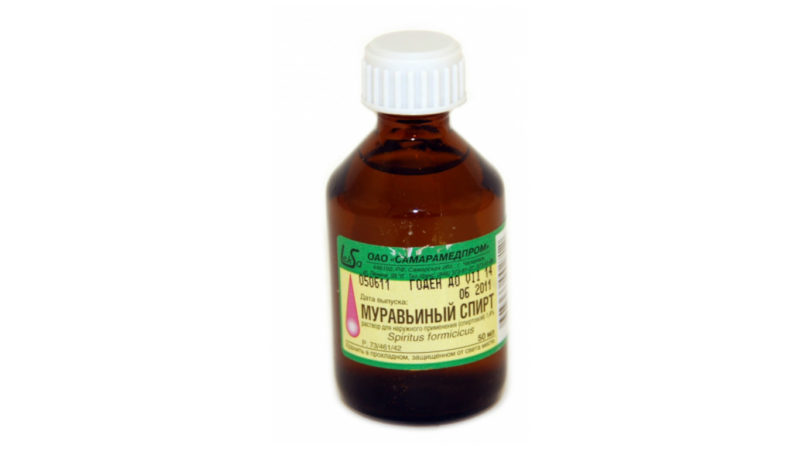
The pharmacological effect of the drug is based on its medicinal properties, which include the ability to:
- reduce pain due to the annoying-distracting effect upon excitation of skin receptors;
- have a disinfecting, cleansing effect;
- reduce inflammation;
- stimulate metabolism, processes of cellular nutrition in tissues due to increased blood flow and vasodilation.
Ant alcohol in all areas of medicine is used exclusively externally as a local analgesic and anti-inflammatory drug.
The local irritating effect of formic acid leads to stimulation of nerve endings, resulting in the release of special protein complexes - endorphins, dynorphins, which can reduce the severity of pain.
The main indications for the use of formic alcohol:
- Pain syndrome with inflammatory phenomena in the joints and muscles - arthritis, myalgia, neuralgia, injuries, damage to tendons, rheumatism, convulsions, thrombophlebitis.
- Violations of metabolic processes in muscle and joint tissue with degenerative phenomena, including arthrosis.
In the treatment of these pathological conditions, the medication helps to enhance blood circulation, due to which the pain is relieved, inflammatory and stagnant phenomena are eliminated, repair (restoration) processes in the tissues are activated.
Instructions for use of the medicinal product provide the following steps:
- Gently rub the product into the skin on unhealthy areas.
- Apply a warming compress, for which use a cotton cloth soaked in diluted alcohol, which is covered with parchment (or polyethylene), a layer of natural cotton wool and a fixing bandage made of wool fiber.
The alcohol for the compress is diluted with water: for adults in a ratio of 1: 3, in the treatment of joints and muscles of the legs or lower back. For the treatment of children over 7 years old, water is added to ant alcohol, observing a proportion of 1: 5.
The duration of the procedure is determined by the severity of the manifestations, the severity of the therapeutic effect and the sensitivity of the skin to the drug.
Compress must be removed when severe itching, burning, and also after the warming action subsides, when there is a feeling of moisture and coolness.
It is forbidden to make compresses during exacerbation of skin diseases, injuries, abscesses, fever.
Application in cosmetology
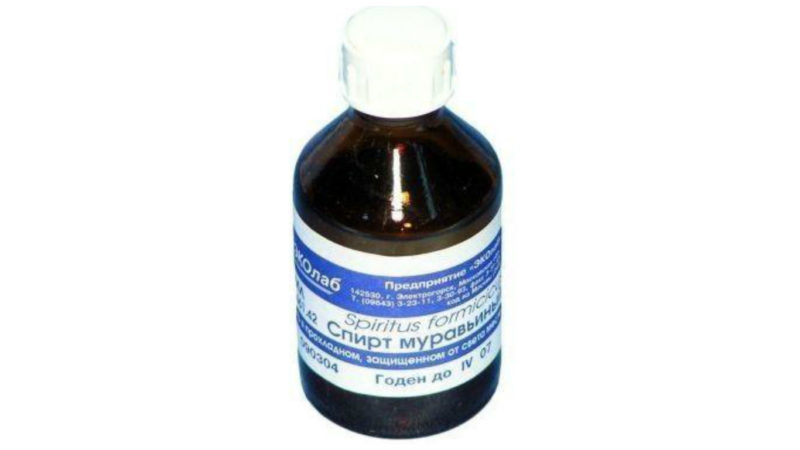
In cosmetology, the antiseptic, cleansing properties of the alcohol-containing product are of particular importance.
Formic alcohol, used topically to treat abnormal skin manifestations, performs the following functions:
- disinfects the affected area, suppressing the activity of pathogenic flora;
- produces a pronounced drying effect;
- helps to reduce inflammation;
- dilates blood vessels;
- cleans pores from excess fat, exfoliated skin particles.
Due to its medicinal properties, ant alcohol is used as the main tool or auxiliary component in complex therapy:
- inflamed acne, acne;
- abnormally high sebum production (sebum secretion) and increased oily skin;
- elimination of the phenomena of post-acne in the form of stagnant spots;
- fungal diseases of the nail plates.
Alcohol is also used as a prophylactic for wiping the skin in order to prevent pressure sores in bedridden patients.
It should be understood that, having a pronounced disinfecting effect, formic alcohol does not have fungicidal activity, that is, it is not able to suppress fungal microorganisms. Therefore, in the treatment of skin and nail fungus, it is used only as an additional tool that will briefly slow down the reproduction processes, increase the ability of the infected area of the nail plate to absorb the active therapeutic substance.
Acne Ant Acne
As a cosmetic cosmetic agent, formic alcohol is used in the external therapy of acne and pustules - elements of a rash with purulent contents that can be follicular (that is, form in the area of the hair follicle), and not associated with the hair follicle. In everyday life, pustular forms are called acne.
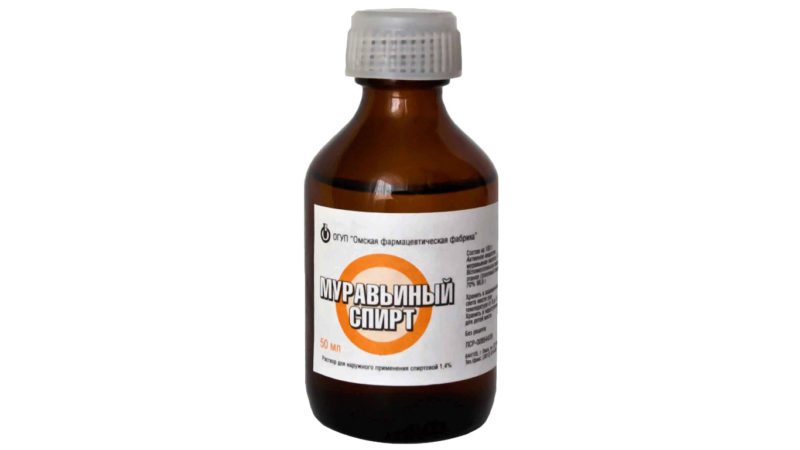
Formic alcohol kills pathogens that cause inflammatory-purulent processes on the skin - epidermal staphylococcus and propionibacteria, reduces the area of inflammation, cleanses the pores.
Rules for use with acne and sore acne:
- In the case of single inflammatory elements, an alcohol-containing solution of formic acid applied pointwise - only on the pustule itself and the area of redness around it, using a cotton swab for this. Repeat the procedure up to 3-4 times a day until the pimple head ripens and completely dries.
- With a large area of rashes, when it is difficult to observe the spot treatment of single acne, a diluted solution of formic alcohol with boiled water in a ratio of 1: 2 (or 1: 3 with dry skin) is applied to the uncleaned skin.
In the intervals between the application of an alcoholic solution, the skin is lubricated with moisturizing or nourishing creams.
Precautions:
- prior to use, it is recommended that you discuss ant alcohol treatment with a dermatologist;
- the product is not used on healthy skin;
- before treatment, the face is not cleaned with other cosmetic and therapeutic agents;
- in order to avoid drying out and irritating the skin, the drug is used no longer than 14 days, then a break of 2 to 3 weeks is necessary to completely restore the level of tissue moisture;
- it is undesirable to use the product with sensitive, dry skin;
- ant alcohol is not used with the simultaneous aggressive cleaning of the epidermis with abrasive chemicals to avoid damage to the skin and its inflammation;
- with the simultaneous use of external therapeutic products with exfoliating effects, the risk of increased dryness and irritation is high.
In addition, it is important to understand that the removal of sebum with alcohol and the cleansing of pores is accompanied by the activation of the sebaceous glands, which after a while begin to more intensively produce sebum to restore the disturbed balance. Therefore, with increased oily skin, in order to maintain a normal level of moisture, it is considered optimal to alternate formic alcohol with milder cleansers.
The use of formic alcohol in folk medicine
Formic alcohol in traditional medicine recipes is used as part of ointments, lotions, compresses for external use.
Important! Never use ant alcohol for oral use, since even in diluted form it can cause burns to the mucous membrane of the mouth, esophagus, and stomach.
If a person is prone to allergies, then an acute anaphylactic reaction to formic acid in the form of laryngeal and pharyngeal edema is quite possible.
Very often, folk recipes offer a combination of formic alcohol and other medicinal substances.

In home medicine, an alcohol solution is used:
- for compresses (not in the acute stage of the disease) and rubbing with hematomas, muscle sprains, dislocations, joint and rheumatic pains, osteochondrosis, salt deposition;
- for the treatment of acne, blackheads, boils;
- for resorption of stagnant spots in the places of the former abscesses due to increased blood flow and expansion of microvessels at the treatment site;
- as one of the components in the treatment of nail mycosis;
- to eliminate itching and inflammation with insect bites (precision treatment 5-6 times a day);
- for exfoliating rough skin (in a 1: 1 mixture with glycerin).
Read also: symptoms and treatment of osteochondrosis of the lumbar spine
Nail Fungus Recipe
A medical talker is being prepared from 2 volumes of formic alcohol, 3 volumes of Dimexide, tar of birch, apple cider vinegar.
The prepared mixture is treated 2 to 3 times a day with infected sites (including the periungual nail) for a long time, until the signs of mycosis and the growth of the young nail plate are removed.
Compress in the acute stage of osteochondrosis
The therapeutic base is prepared from equal volumes of formic, camphor alcohol and mustard powder. Beat 3 proteins, mix with the mixture and put in a cool place for 12 hours. For the compress, a tablespoon of the product is taken, warmed up to body temperature, applied to cotton cloth and applied to the sore spot, soaking to dry completely.
Is it possible for children?
Taking into account all contraindications, adverse side effects and the likelihood of allergies, the drug is approved for external use in young patients not younger than 7 years old and only after consulting a pediatrician.
Side effects
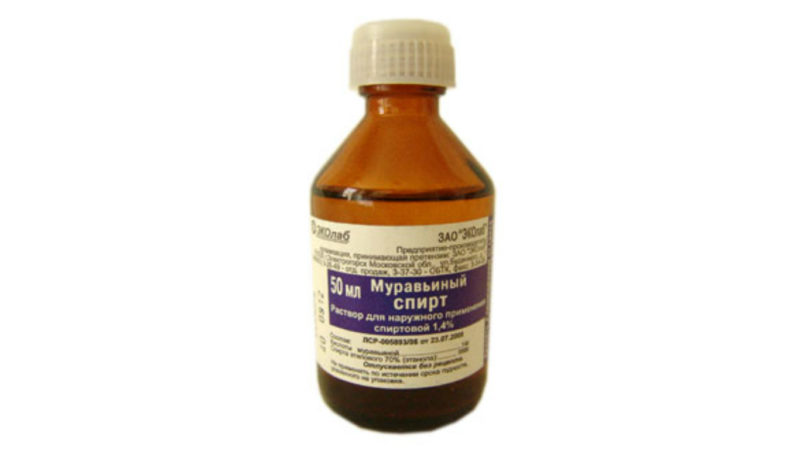
The main adverse reactions of formic alcohol include:
- redness, burning, and itching;
- allergic rashes;
- dryness and peeling of the skin.
To prevent side effects from the medication, for thin, dry, sensitive skin, it is advisable to test for allergies, lubricating the skin on the inner surface of the elbow or behind the auricle, and observe the reaction. If after 6 to 12 hours severe redness, irritation does not appear, then the tool can be used.
It should be remembered that getting into the mucous membranes of the eyes, mouth, even a diluted alcohol solution can cause both a burn and serious gastrointestinal upsets, gastroenteritis phenomena.
Contraindications
The main contraindications:
- individual intolerance;
- pregnancy and breastfeeding (no studies have been conducted);
- age up to 7 years (due to immaturity and special sensitivity of the skin).
In addition, it is not allowed:
- The use of the drug inside, as well as instillation into the ear and nasal passages.
- Application to mucous membranes, ulcers and wounds.
- Skin disinfection at the injection site.
The healing properties of formic alcohol, a small number of adverse reactions and low cost explain its high popularity in people with skin problems, pain in muscles and joints. But, since this is a full-fledged drug, its use should be approached carefully, taking into account the rules of use and the individual characteristics of the patient.
- Victor












